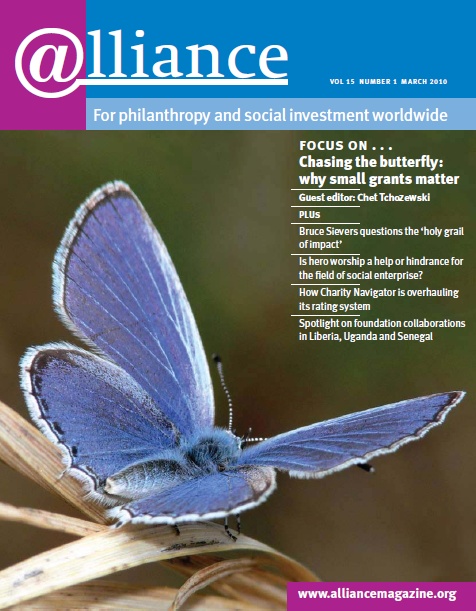There is now widespread recognition that ‘the hour is late’ in relation to the global and systemic environmental challenges faced by humanity. Recent research into funding for environmental causes, however, shows that while environmental grantmaking is growing, it tends to be dispersed over a large number of organizations and issue areas with little sign of the kind of strategic approach that the urgency of the problem demands. One of the problems is inadequate analysis of where grants would do most good. A recent initiative by the Environmental Funders Network sets out to address this deficiency.
The recently published Where The Green Grants Went 4 report forms part of a growing international effort by environmental funder networks to analyse how environmental grants are being distributed. It compares environmental philanthropy in the UK and the US; provides detailed breakdowns of the issues, grantees and geographies receiving most funding; includes case studies of effective climate change philanthropy; and explores questions of effectiveness from different points of view. It also sheds light on the functioning of the grants market in environmental philanthropy, by looking back at five years’ worth of data from UK-based foundations. It is this aspect of the research that is the focus of this article.
It will come as no surprise to Alliance readers that most environmental grants come from a small number of larger environmental foundations. Of the 97 foundations that are the focus of the UK research, the 20 largest accounted for 81 per cent of grants given by value in 2006/07. Recipients of grants are similarly concentrated. The 100 organizations receiving the most funding over the five years in which the UK grants have been tracked (2002/03 to 2006/07) secured 61.6 per cent of total grants by value, though they represent just 5.3 per cent of all grantees by number.
Ups and downs of the environmental grants market
What may be more surprising to readers is the degree of turbulence within the grants market. Levels of environmental funding rose or fell by more than 50 per cent year-on-year for a third of the 97 foundations studied, and by 25-50 per cent for a further 20 foundations. On the grantee side, income from foundations often rises or falls by more than 50 per cent from one year to the next, and in some cases the swings are much larger. A total of 348 (47 per cent) of the grantee organizations that received a grant in 2005/06 got no funding from the same set of 97 foundations the following year. Foundation funding would appear to be a very unstable source of income. This is problematic given the timescale over which most social change occurs, and it is a particular challenge for smaller environmental organizations, for whom foundation grants tend to represent a much higher percentage of overall income.
A ‘scattergun’ approach
When we look beyond the household-name organizations that secure the lion’s share of funding, we see what might best be described as a ‘scattergun’ distribution of grants, broad but shallow. Of the 1,900 different grantees that secured a grant during the five years of research, some 1,096 only ever received one grant. Only 294 organizations (15.4 per cent) managed to secure five or more grants during the five-year period.
In order to explore this scattergun distribution further, we have produced a visual representation of the way in which grants from the 2006/07 financial year are distributed across the 13 ‘issue categories’ used in the report (food and farming, energy, transportation, etc). The map can be downloaded as a PDF file from http://www.greenfunders.org, and changing the zoom setting on the PDF reader allows viewers to move from a ‘bird’s eye view’ down to more detailed examination of specific parts of the map. The box to the left of the map explains the meaning of the different colours that are used. As far as we know, this is the first time that a field of philanthropy has been mapped in this way. If readers know of other similar maps then we would be keen to hear about them.
The foundations featured in the map are ranked in order of size from large to small, in terms of the value of their environmental grants in 2006/07. The foundation making the most grants gave more than £6.5 million to environmental causes that year. The foundation occupying the bottom row of the map gave just £2,500.
Worrying generalism of grantmaking
The scattergun distribution of grants is immediately clear, along with the fact that many grantmakers are generalists, dividing their funding among a large number of different issue categories. Only funders within the ‘biodiversity and species’ column could be said to show any real degree of specialization.
The difference between issues supported by a wide range of funders (biodiversity and species preservation, terrestrial ecosystems, food and farming) and those receiving little support (toxics and pollution, consumption and waste, trade and finance) is also clear. Since work within categories like biodiversity and species preservation or terrestrial ecosystems is already being undermined by climate change and other systemic problems, we find it very worrying that most environmental philanthropy remains concentrated ‘downstream’. Finally, the map shows how most issues have one or two dominant foundation funders, which may be giving more money than all the other foundations combined.
Narrower focus needed
What are the consequences of the scattergun distribution of grants from environmental foundations, both across issue categories and to individual grantees? Does this represent an efficient allocation of resources? Might funders have more collective impact if they pooled knowledge of funding opportunities that best exploit philanthropy’s potential for innovation, risk-taking and speed, so as to provide more generous support to fewer initiatives? Should staff and trustees that specialize in environmental issues get together to provide lists of ‘hot prospects’ for more generalist funders?
From our perspective there would be much to be gained from a tighter focus on initiatives that genuinely bring new ideas into play, and/or which cannot be funded by other types of capital. We would encourage funders to invest more effort in systematically mapping gaps in civil society capacity, along with the levers that can be pulled to drive social and political change. Our collective understanding of the spaces where grants can have the greatest impact is currently very limited, and given the high stakes involved we have a responsibility to raise our game. We would like to work with other funders to develop maps and tools to this end. Please contact jon@greenfunders.org if you are interested in collaborating.
Jon Cracknell is coordinator of the Environmental Funders Network. Email jon@greenfunders.org
For more information
To download Where The Green Grants Went 4 report, go to http://www.greenfunders.org. The map can be found at http://www.greenfunders.org/wp-content/uploads/Patterns-of-our-practice-UK-v1-15.12.09.pdf
Philanthropy Insight
The Foundation Center has developed another tool for visualizing data. This fully searchable, interactive Google-style map charts more than 20,000 foundations and nearly 2 million of their grants around the world. The data comes mainly from US foundations, but several European, African and Middle Eastern foundations have recently joined this effort.
For more information
http://www.philanthropyinsight.org
 Comment Bradford Smith
Comment Bradford Smith
Philanthropy has clearly entered the age of data as foundations strive to collaborate and work at scale to make real progress on pressing global challenges. The revolution in digital technology allows funders to take data and visualize it in ways that reveal patterns in grantmaking as never before, including what Jon Cracknell calls the ‘scattergun’ effect. Environmental funders, perhaps because of a shared sense of urgency, have taken the lead and there are actually a number of parallel efforts under way to visualize their grantmaking patterns, strategic alignment and geographic spread.
Despite the enormous potential of such technology, significant challenges remain. First is the nature of philanthropy itself. Foundations are private institutions that can be as fiercely independent as their strong-minded donors and CEOs. They each tend to establish priorities and make decisions in their own way, which, more often than not, produces the scattergun effect. Second, aggregating data across different foundations can be very difficult because there is no agreed terminology for our field to describe subject, population served, geography or type of support. At the Foundation Center we were recently sifting through 200,000 grants by US foundations and found 81 different terms used to describe ‘general operating support’. Third is the tendency to underestimate the cost of the infrastructure required to collect such information from foundations systematically (they are not always cooperative), maintain it over time and develop ways to visualize it. No single foundation will take on the responsibility of doing this for others and they are often reluctant to sufficiently fund groups like the Environmental Funders Network to do so.
The private and independent nature of foundations is what allows them to act quickly and provide risk capital. But it also means there will never be something akin to centralized planning for philanthropy. Coordination will have to be voluntary and the true promise of data gathering and visualization efforts like this one is to hold up a mirror so foundations can see what they have collectively wrought. The hope is that seeing a scattergun image will provoke reflection, change practice and lead foundations to be more strategic about using their precious resources to achieve greater impact.
Bradford Smith is president of the Foundation Center. Email bks@foundationcenter.org






Comments (0)